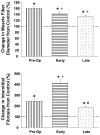Myocardial remodeling with aortic stenosis and after aortic valve replacement: mechanisms and future prognostic implications
- PMID: 21762938
- PMCID: PMC3210937
- DOI: 10.1016/j.jtcvs.2011.04.044
Myocardial remodeling with aortic stenosis and after aortic valve replacement: mechanisms and future prognostic implications
Abstract
Aortic valve stenosis is a common cause of left ventricular pressure overload, a pathologic process that elicits myocyte hypertrophy and alterations in extracellular matrix composition, both of which contribute to increases in left ventricular stiffness. However, clinical and animal studies suggest that increased myocardial extracellular matrix fibrillar collagen content occurs later in the time course of left ventricular pressure overload at a time coincident with severe abnormalities in diastolic function followed by the development of symptomatic heart failure. Aortic valve replacement remains the most effective treatment for elimination of chronic pressure overload secondary to aortic stenosis but has traditionally been recommended only after the onset of clinical symptoms. Long-term follow-up of patients with symptomatic aortic stenosis after aortic valve replacement suggests that valve replacement may not result in complete reversal of the maladaptive changes that occur within the myocardial extracellular matrix secondary to the pressure overload state. To the contrary, residual left ventricular extracellular matrix abnormalities such as these are likely responsible for persistent abnormalities in diastolic function and increased morbidity and mortality after aortic valve replacement. Defining the mechanisms and pathways responsible for regulating the myocardial extracellular matrix during the natural history of aortic stenosis may provide a means by which to detect crucial structural milestones and thereby permit more precise identification of the development of maladaptive left ventricular remodeling.
Published by Mosby, Inc.
Figures



Similar articles
-
Myocardial structure as a determinant of pre- and postoperative ventricular function and long-term prognosis after valve replacement for aortic stenosis.Eur Heart J. 1998 Jul;19(7):1099-108. doi: 10.1053/euhj.1998.0872. Eur Heart J. 1998. PMID: 9717046
-
Symptom Onset in Aortic Stenosis: Relation to Sex Differences in Left Ventricular Remodeling.JACC Cardiovasc Imaging. 2019 Jan;12(1):96-105. doi: 10.1016/j.jcmg.2017.09.019. Epub 2017 Dec 13. JACC Cardiovasc Imaging. 2019. PMID: 29248646
-
Progression of Hypertrophy and Myocardial Fibrosis in Aortic Stenosis: A Multicenter Cardiac Magnetic Resonance Study.Circ Cardiovasc Imaging. 2018 Jun;11(6):e007451. doi: 10.1161/CIRCIMAGING.117.007451. Circ Cardiovasc Imaging. 2018. PMID: 29914867 Free PMC article.
-
The role and clinical implications of diastolic dysfunction in aortic stenosis.Heart. 2017 Oct;103(19):1481-1487. doi: 10.1136/heartjnl-2017-311506. Epub 2017 Jul 6. Heart. 2017. PMID: 28684437 Review.
-
Left ventricular hypertrophy in valvular aortic stenosis: mechanisms and clinical implications.Am J Med. 2015 Apr;128(4):344-52. doi: 10.1016/j.amjmed.2014.10.054. Epub 2014 Nov 25. Am J Med. 2015. PMID: 25460869 Review.
Cited by
-
Large Animal Models of Heart Failure: A Translational Bridge to Clinical Success.JACC Basic Transl Sci. 2020 Aug 24;5(8):840-856. doi: 10.1016/j.jacbts.2020.04.011. eCollection 2020 Aug. JACC Basic Transl Sci. 2020. PMID: 32875172 Free PMC article. Review.
-
Late Gadolinium Enhancement Predicts Improvement in Global Longitudinal Strain after Aortic Valve Replacement in Aortic Stenosis.Sci Rep. 2019 Oct 30;9(1):15688. doi: 10.1038/s41598-019-51930-2. Sci Rep. 2019. PMID: 31666577 Free PMC article.
-
Predictions of hypertrophy and its regression in response to pressure overload.Biomech Model Mechanobiol. 2020 Jun;19(3):1079-1089. doi: 10.1007/s10237-019-01271-w. Epub 2019 Dec 7. Biomech Model Mechanobiol. 2020. PMID: 31813071 Free PMC article.
-
A Computational Model of Ventricular Dimensions and Hemodynamics in Growing Infants.J Biomech Eng. 2023 Oct 1;145(10):101007. doi: 10.1115/1.4062779. J Biomech Eng. 2023. PMID: 37338264 Free PMC article.
-
Left ventricular remodeling and improvement in diastolic function after balloon aortic valvuloplasty for congenital aortic stenosis.Circ Cardiovasc Interv. 2012 Aug 1;5(4):549-54. doi: 10.1161/CIRCINTERVENTIONS.112.968958. Epub 2012 Jun 26. Circ Cardiovasc Interv. 2012. PMID: 22739787 Free PMC article.
References
-
- Badeer HS. Biological significance of cardiac hypertrophy. Am J Cardiol. 1964;14:133–138. - PubMed
-
- Alpert NR. Cardiac hypertrophy. Academic Press, Inc; New York: 1971. Preface; pp. XV–XVI.
-
- Carabello BA, Paulus WJ. Aortic Stenosis. Lancet. 2009;373:956–66. - PubMed
-
- Monrad ES, Hess OM, Murakami T, et al. Time course of regression of left ventricular hypertrophy after aortic valve replacement. Circulation. 1988;77(6):1345–55. - PubMed
Publication types
MeSH terms
Substances
Grants and funding
LinkOut - more resources
Full Text Sources
Medical

